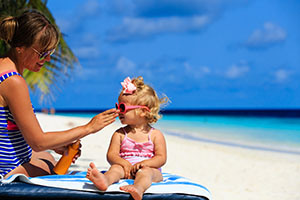Do your summer plans include plans to protect your kids from the sun?
 1. Summer vacations increase sun exposure. (So do winter vacations in snow country.) While you may be savvy about protecting your kids from everyday sun-related hazards, summer vacations add numerous factors to contend with: more hours of sun per day, more time spent outdoors, more intense harmful UV (ultraviolet) radiation, being at the beach or around pools, being closer to the equator, higher altitudes and children taking medication that may enhance sunburns, to mention just a few. All these factors require additional protection.
1. Summer vacations increase sun exposure. (So do winter vacations in snow country.) While you may be savvy about protecting your kids from everyday sun-related hazards, summer vacations add numerous factors to contend with: more hours of sun per day, more time spent outdoors, more intense harmful UV (ultraviolet) radiation, being at the beach or around pools, being closer to the equator, higher altitudes and children taking medication that may enhance sunburns, to mention just a few. All these factors require additional protection.
2. Most parents are too complacent about sunburns in children. Most burns are mild and heal relatively rapidly; symptoms are rarely severe and there is little or no visible scarring. In fact, the sun’s intense ultraviolet radiation on children’s vulnerable skin causes irreversible damage to the DNA in skin cells. This sets off a cascade of negative effects.
 3. Intense, intermittent sun exposure, the kind that occurs on summer vacations, has a worse prognosis than constant tanning. Melanomas, the most serious type of skin cancer, are associated with such exposure. The worse the burn and the younger the age of the child at the time of the burn, the earlier in adulthood melanomas may occur. In a lifetime, two percent of the population experiences melanomas.
3. Intense, intermittent sun exposure, the kind that occurs on summer vacations, has a worse prognosis than constant tanning. Melanomas, the most serious type of skin cancer, are associated with such exposure. The worse the burn and the younger the age of the child at the time of the burn, the earlier in adulthood melanomas may occur. In a lifetime, two percent of the population experiences melanomas.
4. Familiarize yourself with the UV Index. Daily readings of sun intensity are available on the web for every location in the US, Canada, UK and Australia. Forecasts include predictions for the following days and give recommendations for minimizing skin damage based on the day’s sun intensity. See UV Index.
 5. June is a risky month for skin damage. In the northern hemisphere, the sun is almost directly above and shines the most hours. Skin may be especially vulnerable as tans from the previous season, which may offer some protection, have faded. Cool weather plays no role in sun intensity. Intentionally tanning skin at the onset of summer to protect from subsequent burning is counterproductive. Each tan is a mild sunburn and damages the skin. Damage is cumulative for life.
5. June is a risky month for skin damage. In the northern hemisphere, the sun is almost directly above and shines the most hours. Skin may be especially vulnerable as tans from the previous season, which may offer some protection, have faded. Cool weather plays no role in sun intensity. Intentionally tanning skin at the onset of summer to protect from subsequent burning is counterproductive. Each tan is a mild sunburn and damages the skin. Damage is cumulative for life.
 6. Skimpy beach attire has no place in the sun. Dressing up for the beach may be a nuisance but traditional “protective” beach apparel – white T-shirts, for example, especially when wet – provide virtually no protection. Clothing that is virtually 100% protective is available. The more skin covered by such clothing, the greater the protection and the less the need for sunscreens. Infants less than six months of age should be kept out of the sun.
6. Skimpy beach attire has no place in the sun. Dressing up for the beach may be a nuisance but traditional “protective” beach apparel – white T-shirts, for example, especially when wet – provide virtually no protection. Clothing that is virtually 100% protective is available. The more skin covered by such clothing, the greater the protection and the less the need for sunscreens. Infants less than six months of age should be kept out of the sun.
7. Sunscreens are essential for exposed skin, but no panacea. Sunscreens merely slow down tanning, they do not eliminate it. Many parents erroneously believe that sunscreens prevent burning/tanning, and allow children to stay in the sun for prolonged periods of time. Sunscreens are rarely applied correctly. Generally, far too little is applied and it is reapplied too infrequently. Applying the correct amount is expensive. When applying, don’t forget to protect ears, lips, necks, scalp and hands. Sunscreens’ effectiveness is reduced by water, perspiration, wind, humidity and other factors. Occasionally, sunscreens cause rashes. For more information on the use of sunscreens on children go to: http://www.cdc.gov/cancer/skin/basic_info/children.htm
 8. Eye protection is as important as skin protection. Infants’ eyes absorb more harmful radiation than do adults’. Ideally, infants should wear sunglasses or stay out of the sun to reduce the risk of cataracts in later life. Get sunglasses that wrap around towards the ears to protect the sensitive skin of the eyelids. Avoid “fun” or “novelty” sunglasses. These are marketed for young children for fun but offer no protection. Buy sunglasses at reputable stores that sell eyeglasses. Be mindful that having infants keep sunglasses on is challenging.
8. Eye protection is as important as skin protection. Infants’ eyes absorb more harmful radiation than do adults’. Ideally, infants should wear sunglasses or stay out of the sun to reduce the risk of cataracts in later life. Get sunglasses that wrap around towards the ears to protect the sensitive skin of the eyelids. Avoid “fun” or “novelty” sunglasses. These are marketed for young children for fun but offer no protection. Buy sunglasses at reputable stores that sell eyeglasses. Be mindful that having infants keep sunglasses on is challenging.
9. Other protective measures. Hats with four-inch brims help protect the eyes, neck and forehead. Have sunshades on strollers; some specifically block radiation. Being in the shade of a building but having a blue sky or fluffy white clouds directly above offers little protection. Being under a beach umbrella protects from direct radiation but allows considerable radiation reflected from water and sand. Dirt, grass and concrete reflect comparatively little radiation.
10. People of color are less likely than Caucasians to develop melanomas. But when they do occur, the outcome is worse. The reasons: a misconception that dark-skinned people do not get skin cancer and the difficulty in recognizing melanomas in dark skin.
 Miscellaneous. Many over-the-counter and prescription medications including ibuprofen (Motrin, Advil), antihistamines, and anti-acne substances can increase skin sensitivity to the sun, worsening burns. Ask your pharmacist or check the web for more information. UV rays penetrate three feet (one meter) or more of water placing water sport participants at risk. If sun exposure is unavoidable for infants less than six months of age, make the exposure as brief as possible and use the same protection measures (clothing and sunscreens) as for older children. Such protection is safer than risking sunburns. Check the expiration date on sunscreens. Products lose potency after a year or so. Storage at high temperatures also decreases potency.
Miscellaneous. Many over-the-counter and prescription medications including ibuprofen (Motrin, Advil), antihistamines, and anti-acne substances can increase skin sensitivity to the sun, worsening burns. Ask your pharmacist or check the web for more information. UV rays penetrate three feet (one meter) or more of water placing water sport participants at risk. If sun exposure is unavoidable for infants less than six months of age, make the exposure as brief as possible and use the same protection measures (clothing and sunscreens) as for older children. Such protection is safer than risking sunburns. Check the expiration date on sunscreens. Products lose potency after a year or so. Storage at high temperatures also decreases potency.

